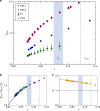Zero-temperature glass transition in two dimensions
- PMID: 30944330
- PMCID: PMC6447585
- DOI: 10.1038/s41467-019-09512-3
Zero-temperature glass transition in two dimensions
Abstract
Liquids cooled towards the glass transition temperature transform into amorphous solids that have a wide range of applications. While the nature of this transformation is understood rigorously in the mean-field limit of infinite spatial dimensions, the problem remains wide open in physical dimensions. Nontrivial finite-dimensional fluctuations are hard to control analytically, and experiments fail to provide conclusive evidence regarding the nature of the glass transition. Here, we develop Monte Carlo methods for two-dimensional glass-forming liquids that allow us to access equilibrium states at sufficiently low temperatures to directly probe the glass transition in a regime inaccessible to experiments. We find that the liquid state terminates at a thermodynamic glass transition which occurs at zero temperature and is associated with an entropy crisis and a diverging static correlation length. Our results thus demonstrate that a thermodynamic glass transition can occur in finite dimensional glass-formers.
Conflict of interest statement
The authors declare no competing interests.
Figures



References
-
- Chaikin, P. M. & Lubensky, T. C. Principles of Condensed Matter Physics (Cambridge University Press, Cambridge, UK 2000).
-
- Berthier L, Biroli G. Theoretical perspective on the glass transition and amorphous materials. Rev. Mod. Phys. 2011;83:587. doi: 10.1103/RevModPhys.83.587. - DOI
-
- Charbonneau P, Kurchan J, Parisi G, Urbani P, Zamponi F. Glass and jamming transitions: from exact results to finite-dimensional descriptions. Annu. Rev. Condens. Matter Phys. 2017;8:265. doi: 10.1146/annurev-conmatphys-031016-025334. - DOI
-
- Kauzmann W. The nature of the glassy state and the behavior of liquids at low temperatures. Chem. Rev. 1948;43:219. doi: 10.1021/cr60135a002. - DOI
Publication types
LinkOut - more resources
Full Text Sources

